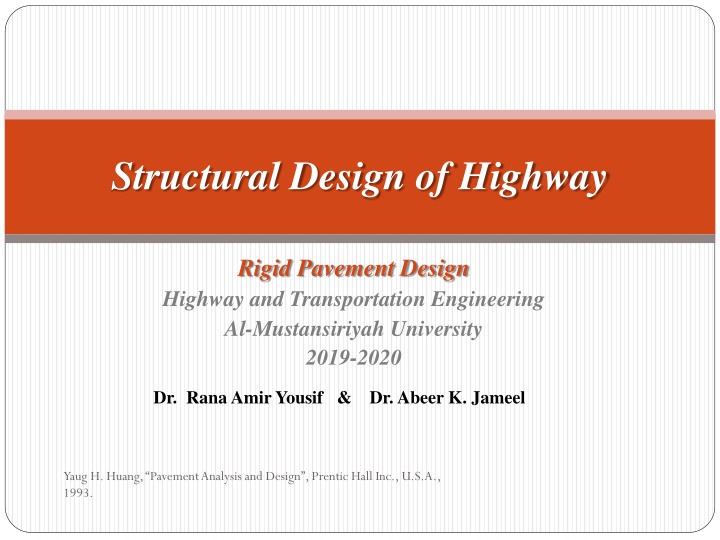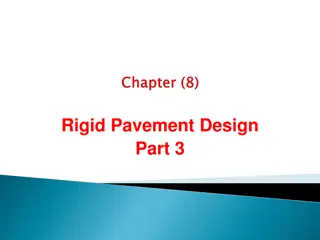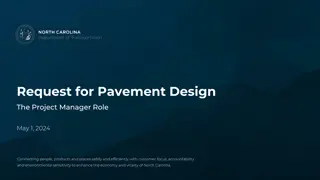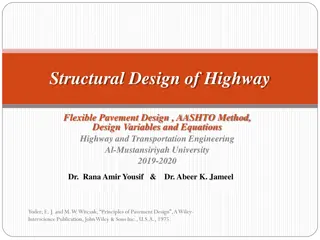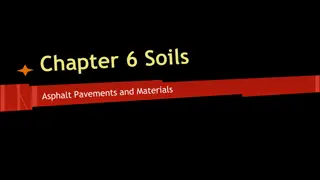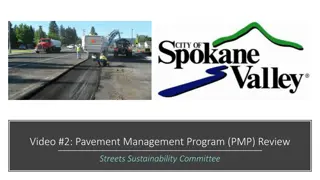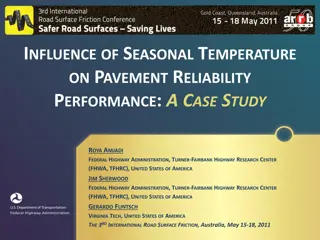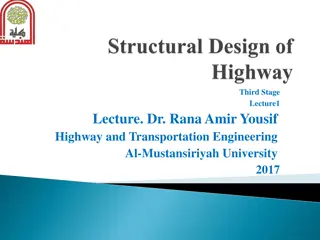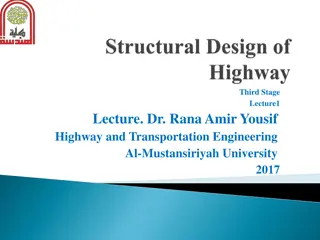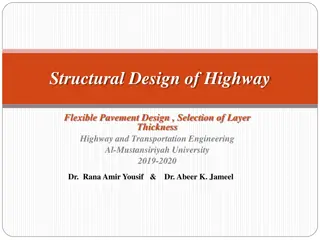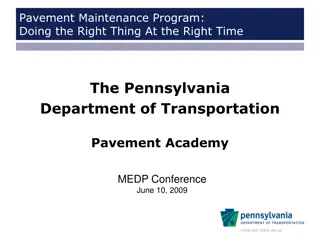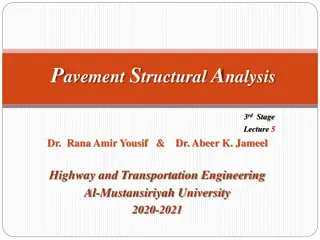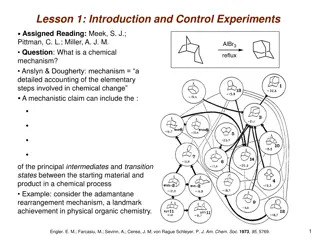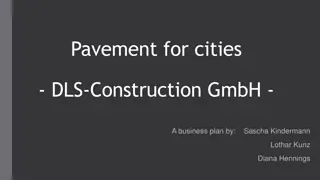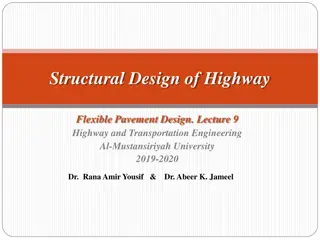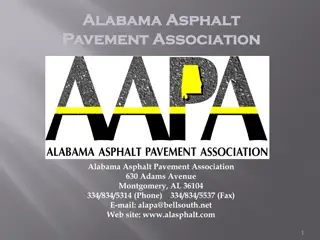Structural Design of Highway Rigid Pavement: Calibrated Mechanistic Procedure
The structural design of highway rigid pavement involves the application of advanced structural models to analyze pavement responses and predict distress types like fatigue cracking and faulting. By calibrating predicted distress with observed distress, the Calibrated Mechanistic Design Procedure ensures accurate pavement performance assessment.
Download Presentation

Please find below an Image/Link to download the presentation.
The content on the website is provided AS IS for your information and personal use only. It may not be sold, licensed, or shared on other websites without obtaining consent from the author.If you encounter any issues during the download, it is possible that the publisher has removed the file from their server.
You are allowed to download the files provided on this website for personal or commercial use, subject to the condition that they are used lawfully. All files are the property of their respective owners.
The content on the website is provided AS IS for your information and personal use only. It may not be sold, licensed, or shared on other websites without obtaining consent from the author.
E N D
Presentation Transcript
Structural Design of Highway Rigid Pavement Design Highway and Transportation Engineering Al-Mustansiriyah University 2019-2020 Dr. Rana Amir Yousif & Dr. Abeer K. Jameel Yaug H. Huang, Pavement Analysis and Design , Prentic Hall Inc., U.S.A., 1993.
References Nicholas J. Garber and Lester A. Hoel. Traffic and Highway Engineering , Fourth Edition. Yoder; E. J. and M. W. Witczak, Principles of Pavement Design , A Wiley- Interscience Publication, John Wiley & Sons Inc., U.S.A., 1975. Yaug H. Huang, Pavement Analysis and Design , Prentic Hall Inc., U.S.A., 1993. AASHTO Guide for Design of Pavement Structures 1993 , AASHTO, American Association of State Highway and Transportation Officials, U.S.A., 1993. Oglesby Clarkson H., Highway Engineering , John Wiley & Sons Inc., U.S.A., 1975. Yaug H. Huang, Pavement Analysis and Design , Prentic Hall Inc., U.S.A., 1993.
CHAPTER 12 Rigid Pavement Design 12.1 CALIBRATED MECHANISTIC DESIGN PROCEDUR E As with flexible pavements, the Calibrated Mechanistic Design Procedure involves the application of structural models to calculate pavement responses, the development of distress models to predict pavement distress from structural responses, and the calibration of the predicted distress with the observed distress on in-service pavements . The structural models for rigid pavement analysis are more advanced than the distress models. Yaug H. Huang, Pavement Analysis and Design , Prentic Hall Inc., U.S.A., 1993. Notes
CHAPTER 12 Rigid Pavement Design 12.1 CALIBRATED MECHANISTIC DESIGN PROCEDUR E The major types of distress to be modeled include fatigue cracking , pumping, faulting, and joint deterioration for jointed concrete pavements and punch outs for continuous reinforced concrete pavements . Yaug H. Huang, Pavement Analysis and Design , Prentic Hall Inc., U.S.A., 1993. Notes
CHAPTER 12 Rigid Pavement Design 12.1 CALIBRATED MECHANISTIC DESIGN PROCEDUR E 12.1.1 Structural Models: To analyze rigid pavement systems accurately, Report 1-26 (NCHRP, 1990) indicated that the structural models used must have the following minimum capabilities : 1. To analyze slabs of any arbitrary dimensions . 2.To analyze systems with two layers (slab and subbase), either bonded or unbonded , with the same or different material properties. 3. To analyze slab systems on either a liquid or a solid subgrade 4.To analyze slab systems with either uniform or nonuniform support, so that loss of support due to erosion or other causes can be taken into account . Yaug H. Huang, Pavement Analysis and Design , Prentic Hall Inc., U.S.A., 1993.
CHAPTER 12 Rigid Pavement Design 5.To analyze multiple slabs with load transfer across the joints or cracks . 6.To consider slab warping and curling simultaneously with load responses. 7.To analyze slabs with variable crack spacings for CRCP design . 8.To analyze slabs with any arbitrary loading conditions, including single or multiple wheels, variable tire pressures, and loads applied at arbitrary assigned distances from cracks, joints, or slab edges . 9.To analyze pavement systems with arbitrary shoulder conditions, including asphalt shoulders, tied concrete shoulders, and extended driving lanes with asphalt or concrete shoulders beyond the extended slab. 10.To analyze systems with nonuniform slab or shoulder thicknesses. Yaug H. Huang, Pavement Analysis and Design , Prentic Hall Inc., U.S.A., 1993.
CHAPTER 12 Rigid Pavement Design Report 1-26 also indicated that the finite element programs require a large computer core capacity, and conventional personal computers with a core capacity of 640 K are not adequate to obtain reliable and accurate results . Notes Yaug H. Huang, Pavement Analysis and Design , Prentic Hall Inc., U.S.A., 1993.
CHAPTER 12 Rigid Pavement Design This statement was true at the time of the report . With the recent advance in personal computers and the introduction of the Windows operating system, core capacity is no longer a problem . However, a large finite- element program still requires a considerable time to run . One way to reduce the computer time needed is to develop algorithms or regression equations to replace structural models for calculating pavement responses (Zollinger and Barenberg, 1989) . These algorithms can be developed by running a finite element program thousands of times and fitting the results with regression equations. Yaug H. Huang, Pavement Analysis and Design , Prentic Hall Inc., U.S.A., 1993.
CHAPTER 12 Rigid Pavement Design 12.1 .2 Fatigue Cracking Models The fatigue of PCC was described in Section 7.3.2. As with flexible pavements, the accumulation of fatigue damage can be expressed as a summation of damage ratios, defined as the ratio between predicted and allowable number of load repetitions . However, instead of relating to tensile strain, the allowable number of load repetitions is related to the stress ratio, which is the ratio between the flexural stress and the modulus of rupture . Yaug H. Huang, Pavement Analysis and Design , Prentic Hall Inc., U.S.A., 1993.
CHAPTER 12 Rigid Pavement Design 12.1 .2 Fatigue Cracking Model s Truck Load Placement: The fatigue of concrete can cause both transverse cracking , which initiates at the pavement edge midway between transverse joints, and longitudinal cracking, which initiates in the wheel paths at transverse joints, usually at the wheel path nearest the slab centerline. Figure 12.2 shows the most critical loading and stress locations to be considered for fatigue analysis . Transverse cracking is caused by the mid- slab edge loading, and longitudinal cracking is caused by the joint loading . Yaug H. Huang, Pavement Analysis and Design , Prentic Hall Inc., U.S.A., 1993.
Yaug H. Huang, Pavement Analysis and Design, Prentic Hall Inc., U.S.A., 1993.
CHAPTER 12 Rigid Pavement Design 12.1 .2 Fatigue Cracking Model s Yaug H. Huang, Pavement Analysis and Design , Prentic Hall Inc., U.S.A., 1993.
CHAPTER 12 Rigid Pavement Design 12.1 .2 Fatigue Cracking Model s The lateral distribution of traffic means that wheel loads are not applied at the same location, so only a fraction of the load repetitions need be considered for fatigue damage. Notes Yaug H. Huang, Pavement Analysis and Design , Prentic Hall Inc., U.S.A., 1993.
CHAPTER 12 Rigid Pavement Design 12.1 .2 Fatigue Cracking Model s Curling Stress: Report 1-26 suggested the use of combined loading and curling stresses for determining the stress ratio and thus the allowable number of load repetitions . Yaug H. Huang, Pavement Analysis and Design , Prentic Hall Inc., U.S.A., 1993.
Yaug H. Huang, Pavement Analysis and Design, Prentic Hall Inc., U.S.A., 1993.
CHAPTER 12 Rigid Pavement Design 12.1 .3 Pumping and Erosion Model s There is an important mode of distress in addition to fatigue cracking that needs to be addressed in the design of rigid pavements . This is the pumping and erosion of material beneath and beside the slab . In fact, most of the failures in the Maryland and AASHO road tests were the result of pumping. Factors that influence pumping and erosion include the presence of water, the rate at which water is ejected under the slab, the erodibility of the subbase material, the magnitude and number of repeated loads, and the amount of deflection . Yaug H. Huang, Pavement Analysis and Design , Prentic Hall Inc., U.S.A., 1993.
Yaug H. Huang, Pavement Analysis and Design, Prentic Hall Inc., U.S.A., 1993.
CHAPTER 12 Rigid Pavement Design 12.1 .4 Faulting Models Faulting at transverse joints is a serious problem that can lead to severe roughness in jointed concrete pavements. The mechanisms of faulting distress in doweled pavements are quite different from those in un-doweled pavements . Doweled Pavements Faulting of doweled pavements is caused by the erosion of concrete around the dowels under repeated loading . Because the design of dowels is based on the bearing stress between dowel and concrete. The maximum bearing stress on dowel bars can be obtained directly by the finite - element computer programs. Yaug H. Huang, Pavement Analysis and Design , Prentic Hall Inc., U.S.A., 1993.
CHAPTER 12 Rigid Pavement Design 12.1 .4 Faulting Models Undoweled Pavements To date, no mechanistic-based analyses have been attempted for un-doweled pavements. Yaug H. Huang, Pavement Analysis and Design , Prentic Hall Inc., U.S.A., 1993.
CHAPTER 12 Rigid Pavement Design 12.1 .5 Joint Deterioration Undoweled Pavements Joint deterioration includes spalling and general breakup of the concrete near the joints. No mechanistic methods have been developed to analyze joint deterioration . The most important factor that causes joint deterioration is the "D" cracking of concrete , as described in Section 9.1.2. Therefore, the use of aggregates that do not cause "D" cracking is the first requisite to prevent joint deterioration . Yaug H. Huang, Pavement Analysis and Design , Prentic Hall Inc., U.S.A., 1993.
CHAPTER 12 Rigid Pavement Design 12.1 .6 Punchout Models Punchouts are the primary mode of distress in CRCP, as described in Section 9.1.2 . If this type of distress could be eliminated, CRCP would have an outstanding performance record. A comprehensive study was made by Zollinger punchout distress. He described four modes of distress that eventually lead to punchout, as illustrated in Figure 12.7 . (1989) on FIGURE 12 .7 Failure modes leading to punchout distress. (After Zollinger and Barenberg (1990) .)
AASHTO METHOD The design guide for rigid pavements was developed at the same time as that for flexible pavements and was published in the same manual . The design is based on the empirical equations obtained from the AASHO Road Test, with further modifications based on theory and experience . In this section, only the thickness design is presented . The design of steel reinforcements and tie bars is similar to that discussed in Section 4 .3 .2 and is not presented here. A comprehensive survey conducted in 1994 and 1995 (Jiang et al.) showed that most state highway agencies used some version of the AASHTO pavement design procedures for rigid pavements. About 84 percent used either the 1972 or 1986/1993 AASHTO design procedures for rigid pavement design, about 4 percent (two states) used the PCA method , and the remaining states (12 percent) used their own design procedures . Yaug H. Huang, Pavement Analysis and Design , Prentic Hall Inc., U.S.A., 1993.
Structural Design of Highway Dr. Rana Amir Yousif & Dr. Abeer K. Jameel Yaug H. Huang, Pavement Analysis and Design , Prentic Hall Inc., U.S.A., 1993.
